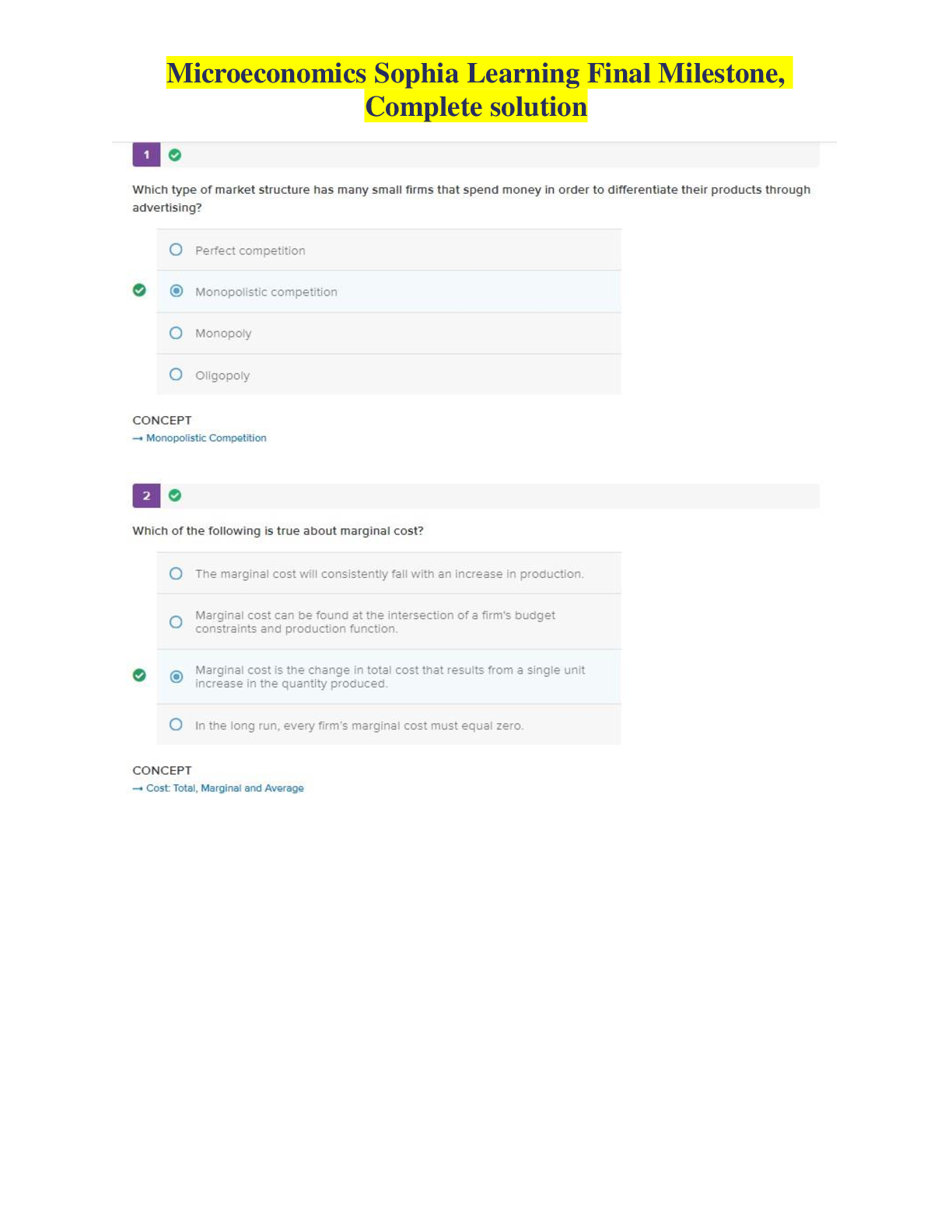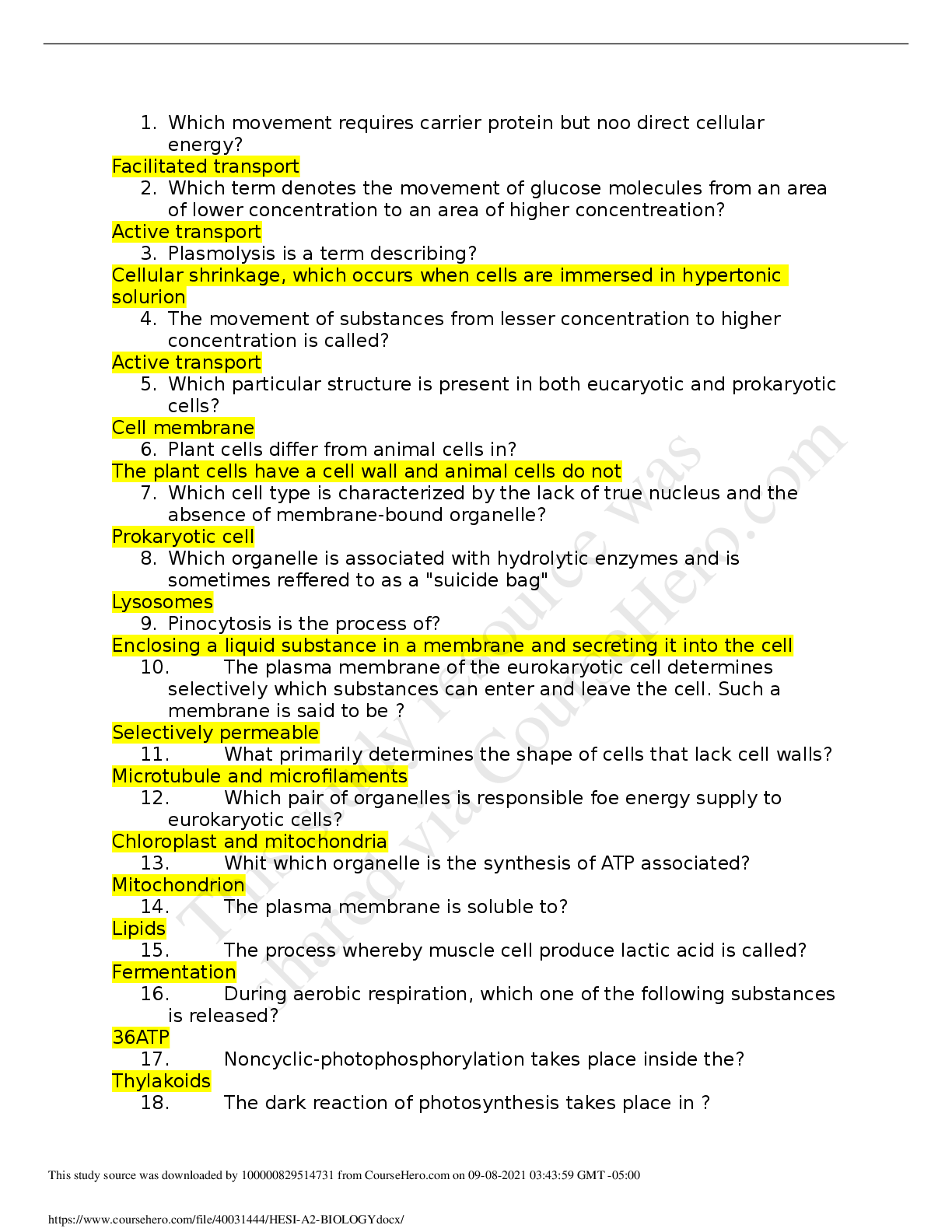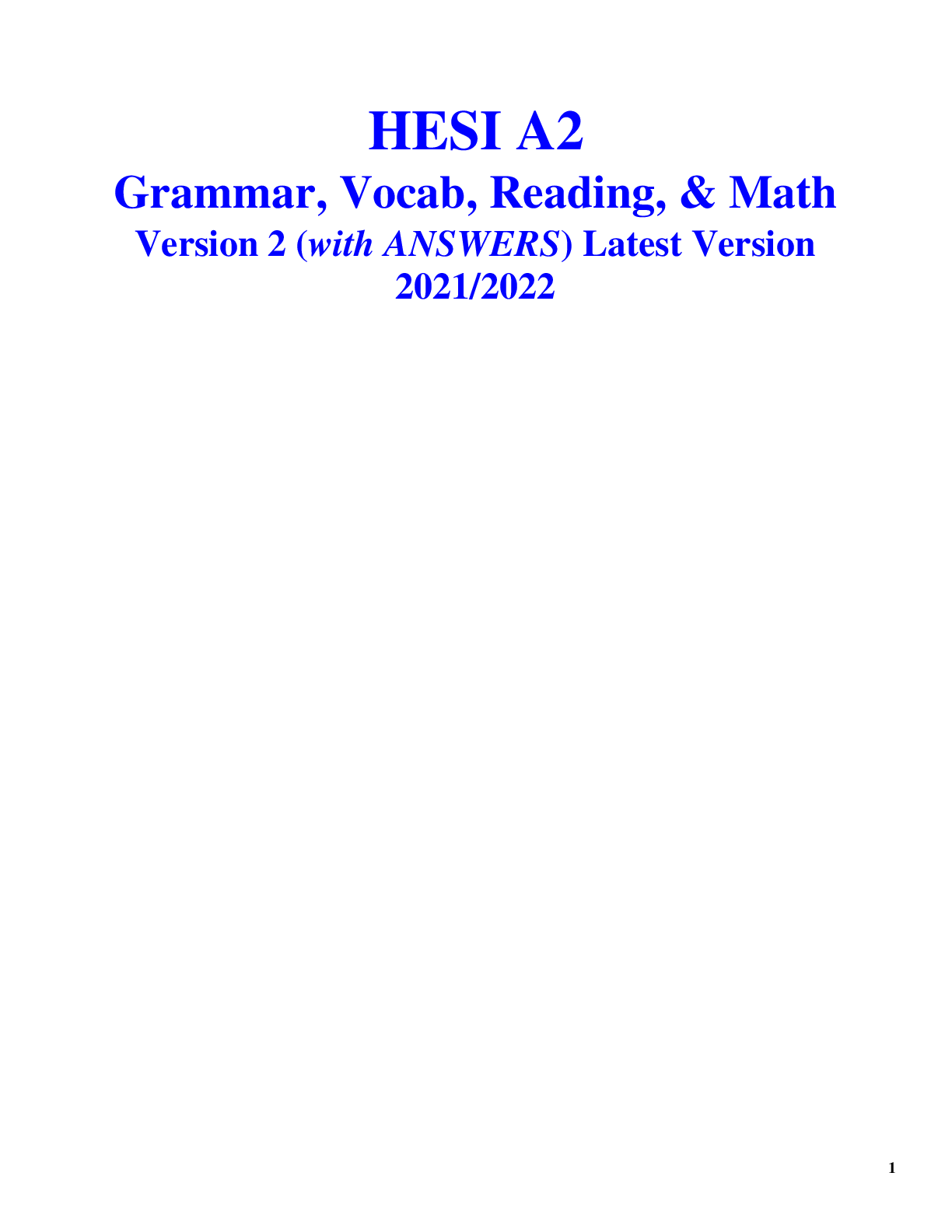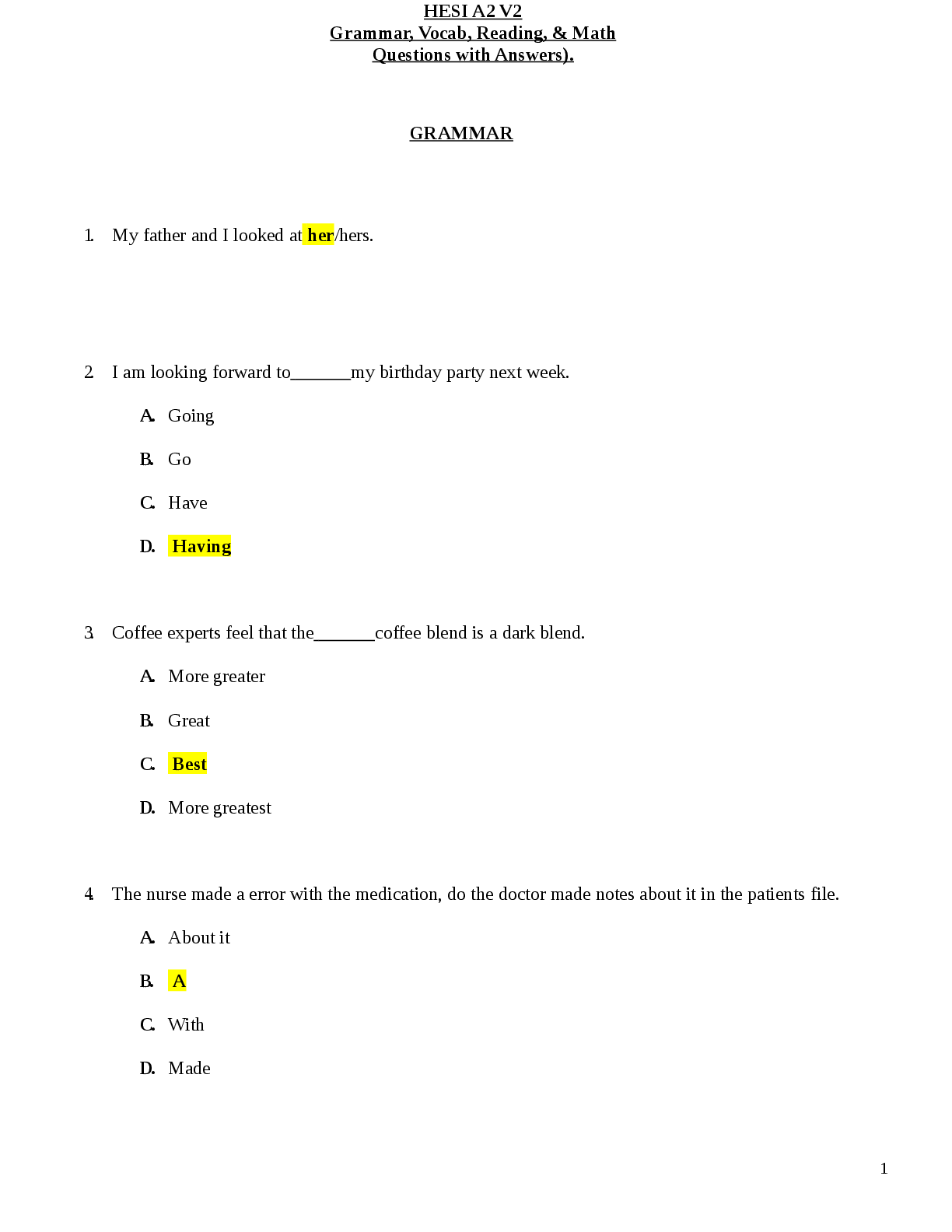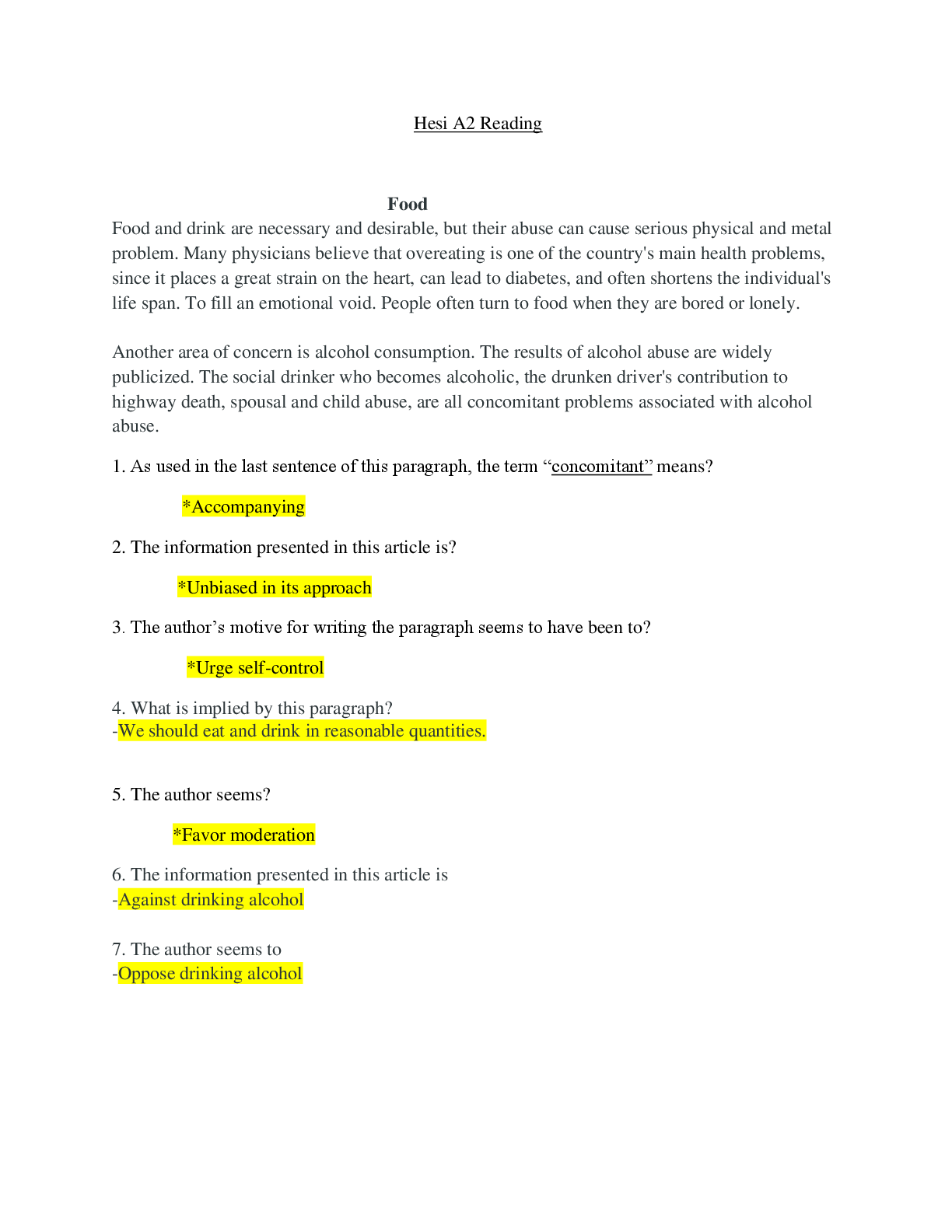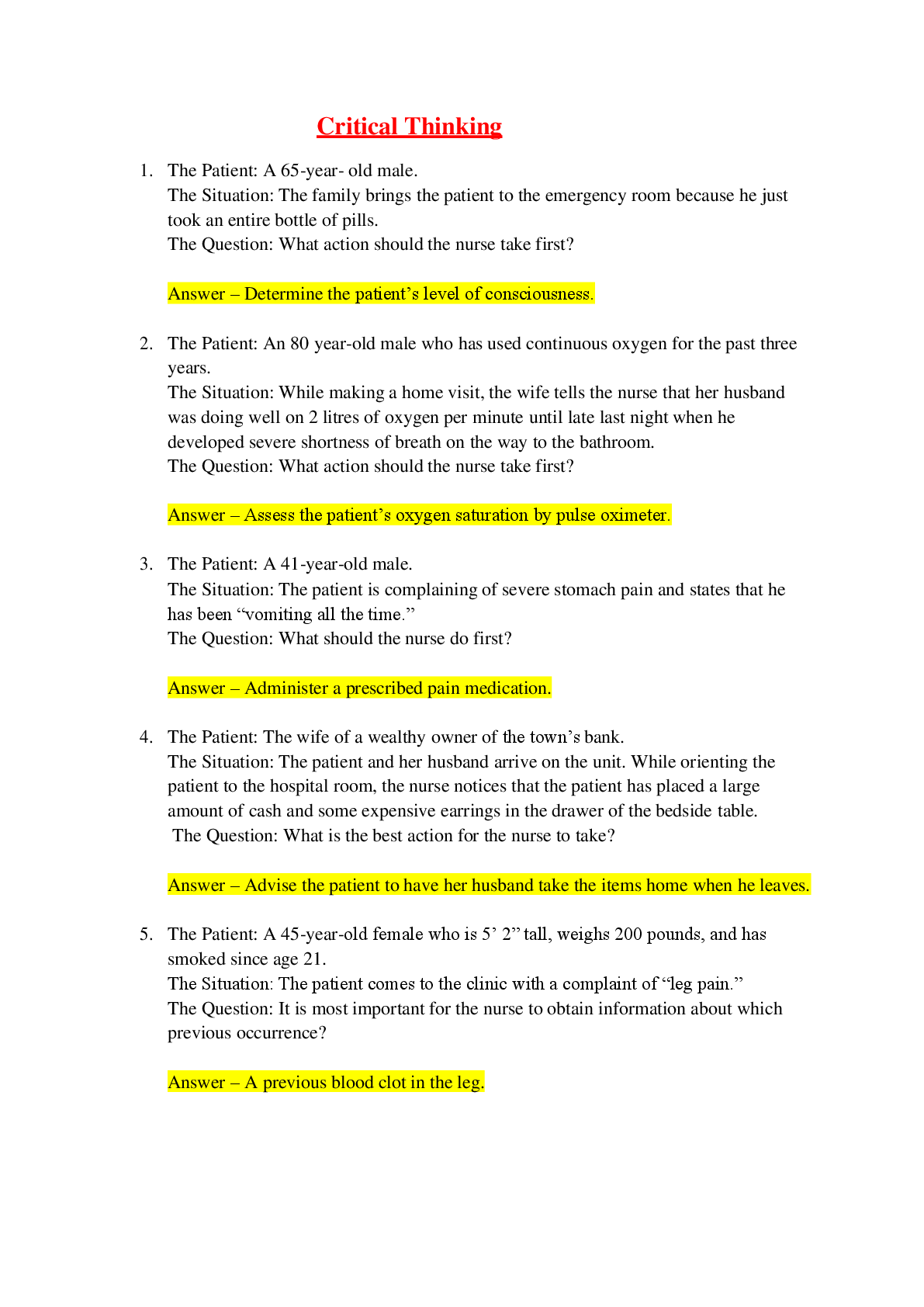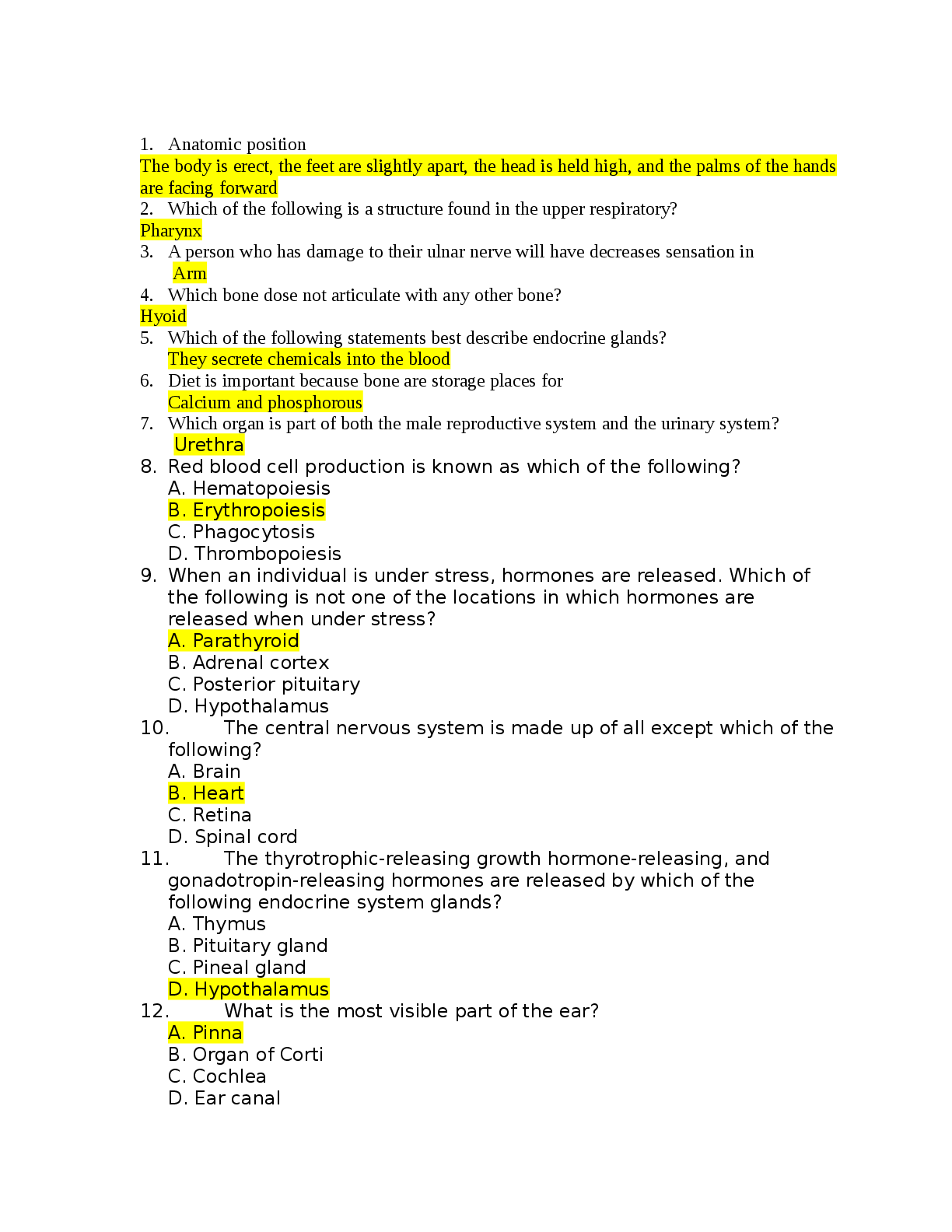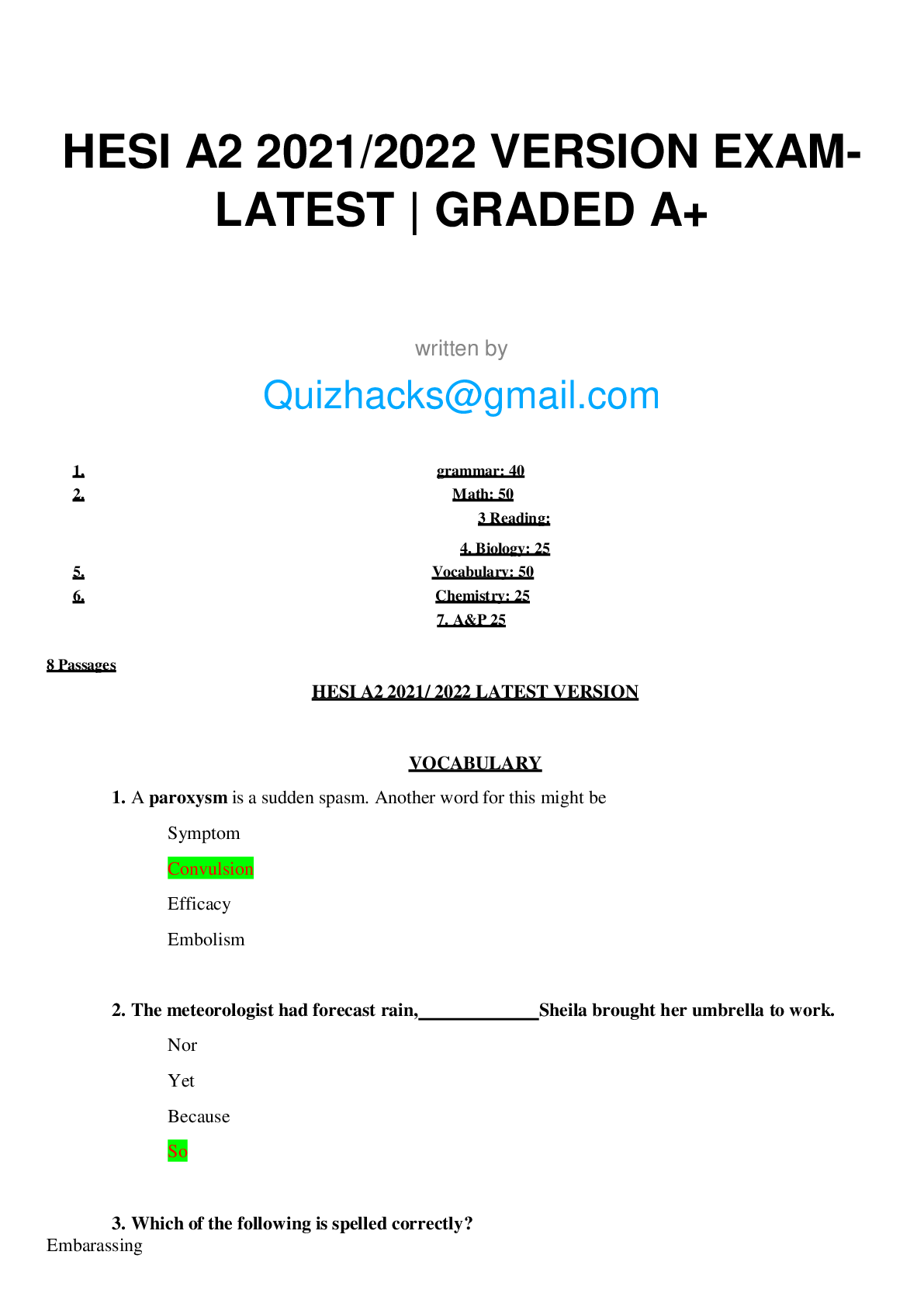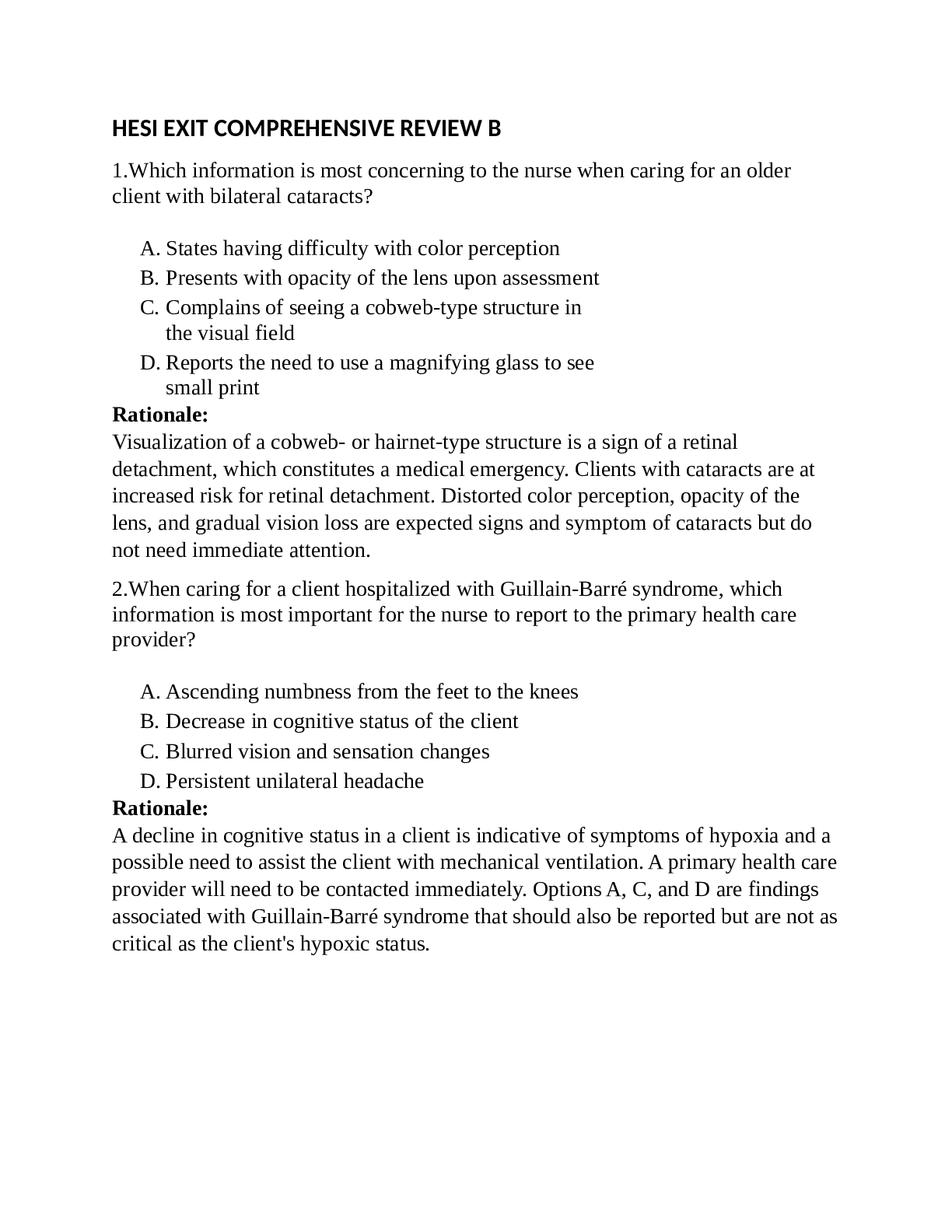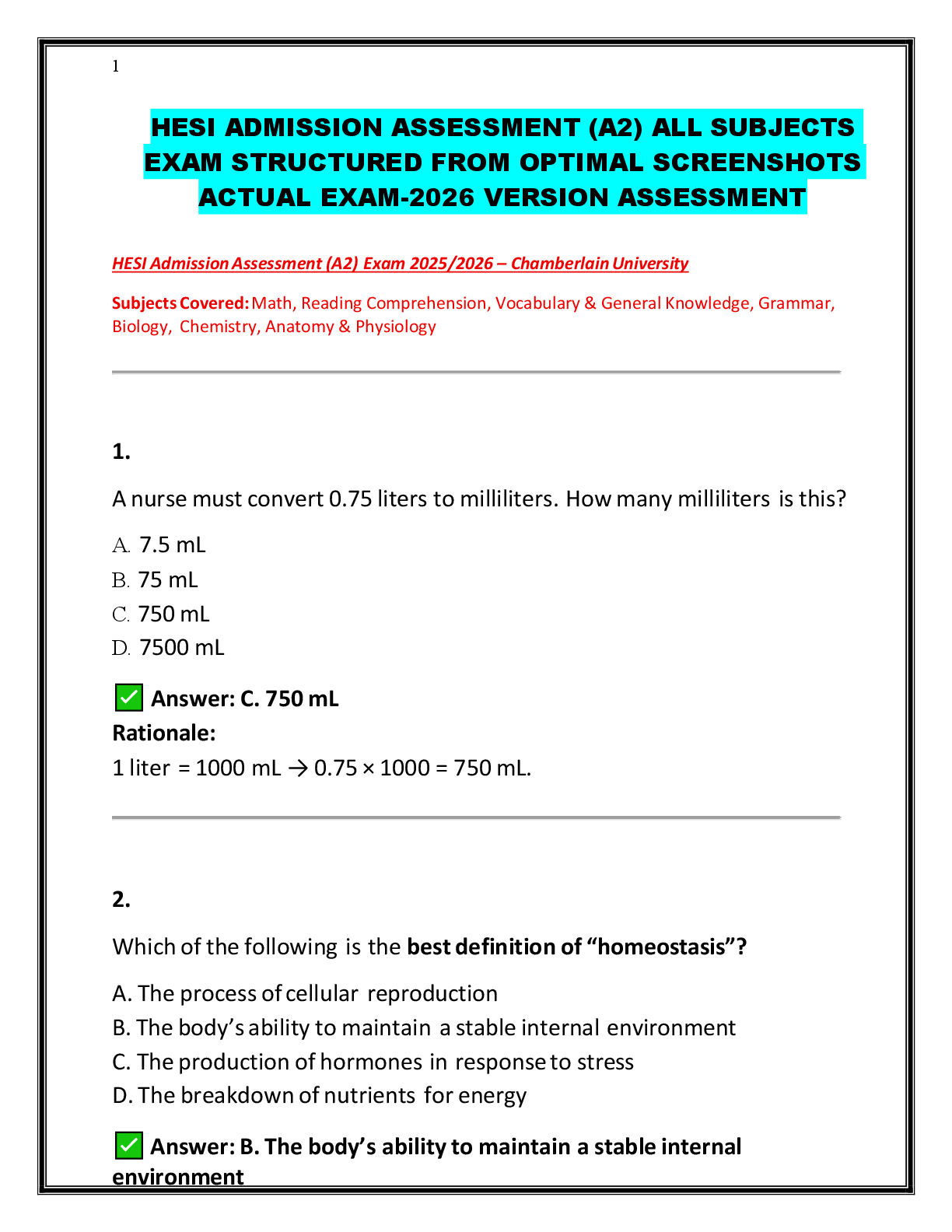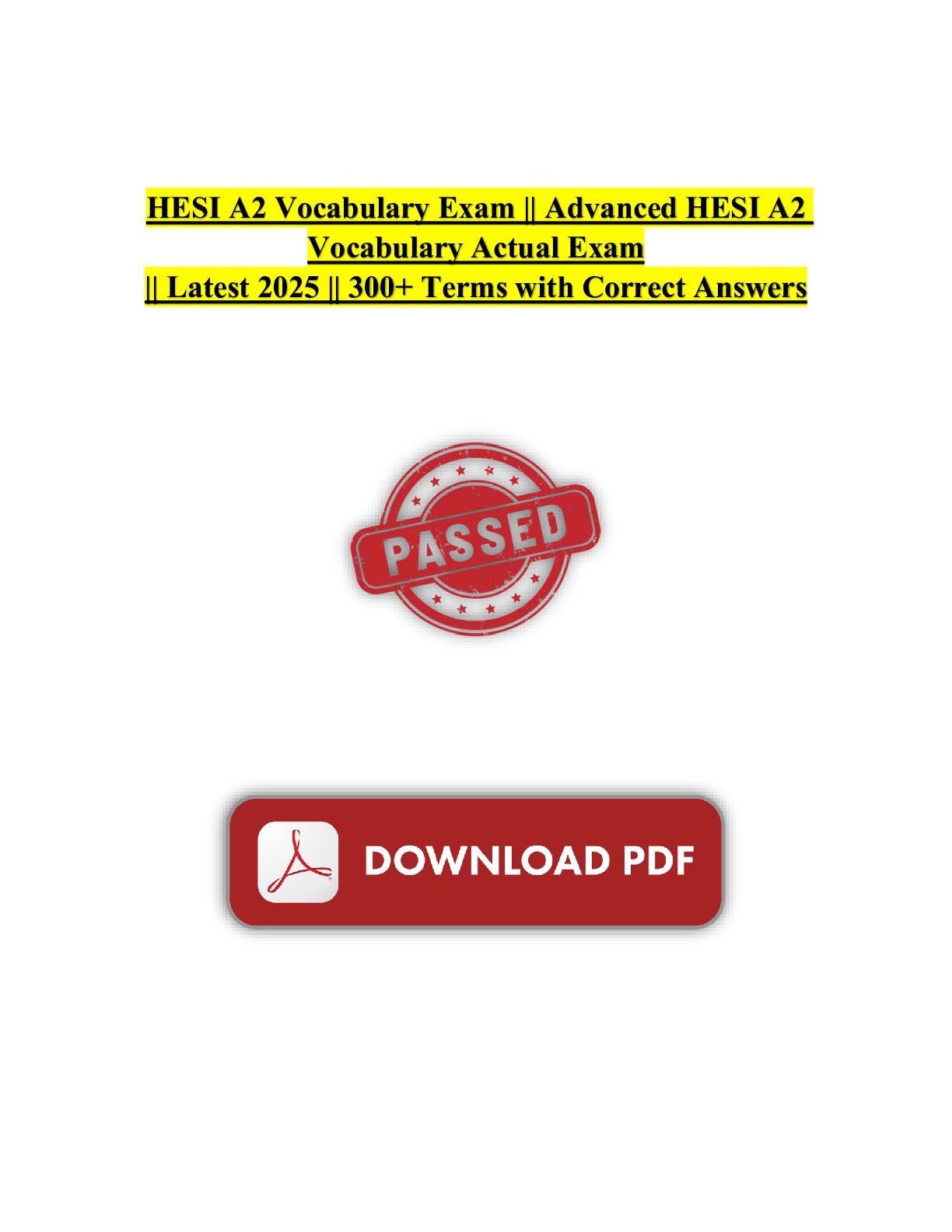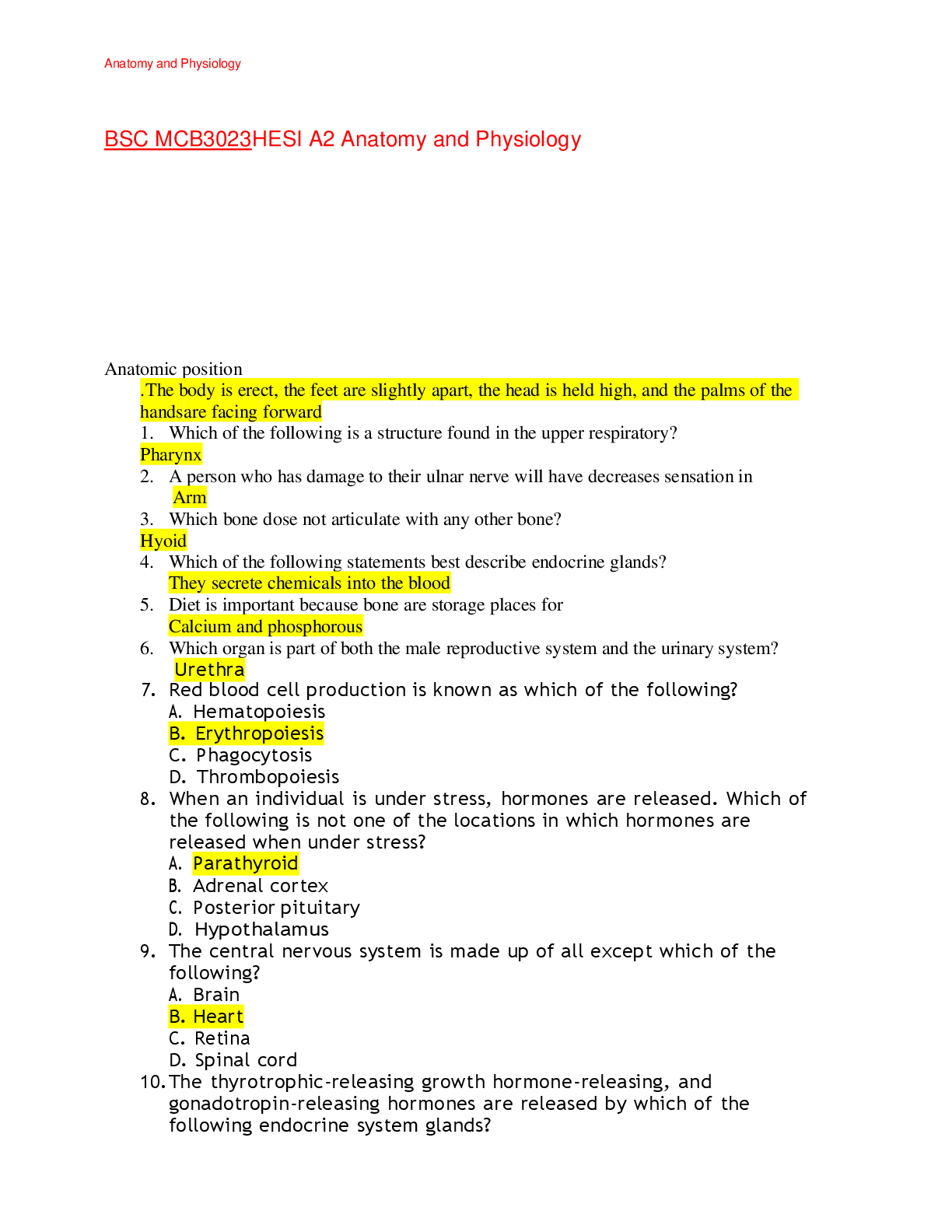Hesi Critical Thinking
Document Content and Description Below
Hesi Critical Thinking
1. The nurse is working in the emergency department (ED) of a children's medical
center. Which client should the nurse assess first?
Correct - 3-The child hit by a car should
...
be assessed first because he or she may have
life- threatening injuries that must be assessed and treated promptly.
2. The 8-year-old client diagnosed with a vaso-occlusive sickle cell crisis is complaining
of a severe headache. Which intervention should the nurse implement first?
Correct - 2-Because the client is complaining of a headache, the nurse should first rule
out cerebrovascular accident (CVA) by assess- ing the client's neurological status and
then determine whether it is a headache that can be treated with medication.
3. The 6-year-old client who has undergone abdominal surgery is attempting to make a
pinwheel spin by blowing on it with the nurse's assistance. The child starts crying
because the pinwheel won't spin. Which action should the nurse implement first?
Correct -1. The nurse should always praise the child for attempts at cooperation even if
the child did not accomplish what the nurse asked.
4. The nurse is caring for clients on the pediatric medical unit. Which client should the
nurse assess first?
Correct - 4. A pulse oximeter reading of less than 93% is significant and indicates
hypoxia, which is life threatening; therefore, this child should be assessed first.
5. The nurse has received the a.m. shift report for clients on a pediatric unit. Which
medication should the nurse administer first?
Correct - 3-Sliding scale insulin is ordered ac, which is before meals; therefore, this
medication must be administered first after receiving the a.m. shift report.
4-Routine medications have a 1-hour leeway before and after the scheduled time;
therefore, this medication does not have to be adminis- tered first.
6. A 5-year-old boy is being admitted to the hospital to have his tonsils removed. Which
information should the nurse collect before this procedure?
D. Reactions to previous hospitalizations
Rationale
Assess how the child reacted to hospitalization and any complications. If the child
reacted poorly, he or she may be afraid now and will need special preparation for the
examination that is to follow. The other items are not significant for the procedure
7. A 6-month-old infant has been brought to the well-child clinic for a check-up. She is
currently sleeping. What should the nurse do first when beginning the examination?
) Auscultate the lungs and heart while the infant is still sleeping.
Rationale
When the infant is quiet or sleeping is an ideal time to assess the cardiac, respiratory,
and abdominal systems. Assessment of the eye, ear, nose, and throat are invasive
procedures and should be performed at the end of the examination.
6. The nurse enters the client's room and realizes the 9-month-old infant is not breathing. Which interventions should the nurse implement? Prioritize the nurse's actions from
first (1) to last (5).
Rationale
Correct Answer: 4, 5, 3, 2, 1
4. The nurse must first determine the
infant's responsiveness by thumping the
baby's feet.
5. The nurse should then open the child's
airway using the head-tilt chin-lift tech- nique, with care taken not to hyperextend the
neck. Then the nurse should look, listen, and feel for respirations.
3. The nurse then administers quick puffs of air while covering the child's mouth and
nose, preferably with a rescue mask.
2. The nurse should determine whether the infant has a pulse by checking the brachial
artery.
1. If the infant has no pulse, the nurse should begin chest compressions using two
fingers at a rate of 30:2.
7. The 3-year-old client has been admitted to the pediatric unit. Which task should the
nurse instruct the unlicensed assistive personnel (UAP) to perform first?
Correct - 1.The first intervention after the child is ad- mitted to the unit is to orient the
parents and child to the room, the call system, and the hospital rules, such as not
leaving the child alone in the room.
8. The clinic nurse is preparing to administer an intramuscular (IM) injection to the 2-
year-old toddler. Which intervention should the nurse implement first?
Correct - 2-The nurse must explain any procedure in words the child can understand. It
does not matter how old the child is.
. The nurse is writing a care plan for the 5-year-old child diagnosed with gastroenteritis.
Which client problem is priority?
Correct - 2-The child diagnosed with gastroenteritis is at high risk for hypovolemic shock
resulting from vomiting and diarrhea; therefore, maintaining fluid and elec- trolyte
homeostasis is priority.
10. Which data would warrant immediate intervention from the pediatric nurse? 1.
Proteinuria for the child diagnosed with nephrotic syndrome.
Correct - 3-Drooling indicates the child is having trouble swallowing, and the epiglottis is
at risk of completely occluding the air- way. This warrants immediate interven- tion. The
nurse should notify the HCP and obtain an emergency tracheostomy tray for the
bedside.
11. Which client should the pediatric nurse assess first after receiving the a.m. shift
report? 4. The 13-month-old child diagnosed with diarrhea who has sunken eyeballs
and
decreased urine output.
Rationale
Correct - 4. Sunken eyeballs and decreased urine out- put are signs of dehydration,
which is a life-threatening complication of diarrhea; therefore, this child should be
assessed first.
12. The pediatric clinic nurse is triaging telephone calls. Which client's parent should the
nurse call first?
1. The 4-month-old child who had immunizations yesterday and the parent is report- ing
a high-pitched cry and a 103°F fever.
Correct 1-A high fever and high-pitched crying may indicate a reaction to the
immunizations; therefore, this parent needs to be called first to bring the child to the
clinic.
13. The parent of a 12-year-old male child with a left below-the-knee cast calls the pediatric clinic nurse and tells the nurse, "My son's foot is cold and he told me it feels like his
foot is asleep." Which action should the nurse implement first?
3. Instruct the parent to elevate the left leg on two pillows.
Correct - 3. The nurse should first take care of the client's body by having the parent
elevate the left leg.
14. Which child requires the nurse to notify the healthcare provider?
1. The 1-year-old child with iron deficiency anemia who has dark-colored stool.
2. The 3-year-old child with phenylketonuria (PKU) whose parent does not feed the
child any meat or milk products.
3. The 5-year-old child with rheumatic heart fever who is having difficulty breathing.
4. The 7-year-old child diagnosed with acute glomerulonephritis who has dark
"tea"-colored urine.
Rationale
Correct - 3-A complication of rheumatic heart disease is valvular disorders that may be
mani- fested by respiratory problems; therefore, the nurse should notify the child's
health- care provider.
15. The pediatric nurse on the surgical unit has just received a.m. shift report. Which
client should the nurse assess first?
1. The 3-week-old child 1 day postoperative with surgical repair of a myelomeningocele who has bulging fontanels.
Correct - 1-Bulging fontanels is a sign of increased intracranial pressure, which is a
compli- cation of neurological surgery; therefore, this child should be assessed first.
16. The charge nurse has assigned a staff nurse to care for an 8-year-old client
diagnosed with cerebral palsy. Which nursing action by the staff nurse would warrant
immediate intervention by the charge nurse?
4. The staff nurse places the child in semi-Fowler's position to eat lunch.
Rationale
Correct - 4-The child should be positioned upright to prevent aspiration during meals;
there- fore, this action would require the charge nurse to intervene.
17. The nurse and the unlicensed assistive personnel (UAP) are caring for clients on the
pediatric unit. Which action by the nurse indicates appropriate delegation?
4. The nurse checks to make sure the UAP's delegated tasks have been completed.
Rationale
Correct - 4. The last step of delegating to a UAP is for the nurse to evaluate and
determine whether the delegated tasks have been completed and performed correctly.
This indicates the nurse has delegated appropriately.
18. The nurse on a pediatric unit has received the a.m. shift report and tells the unlicensed assistive personnel (UAP) to keep the 2-year-old child NPO for a procedure. At
0830, the nurse observes the mother feeding the child. Which action should the nurse
implement first?
1. Determine what the UAP did not understand about the instruction.
Rationale
Correct - 1.Communication to the UAP must be clear, concise, correct, and complete.
The nurse must determine why there was a lack of communication, which resulted in
the child receiving food; therefore, this action should be implemented first.
19. The charge nurse on the six-bed pediatric burn unit is making shift assignments and
has one registered nurse (RN), one scrub technician, one unlicensed assistive
personnel (UAP), and a unit secretary. Which client care assignment indicates the best
use of the hospital personnel?
1. The RN performs daily whirlpool dressing changes.
2. The unit secretary transcribes the HCP's orders.
3. The scrub technician medicates the client prior to dressing changes. 4. The UAP
places the current laboratory results on the chart.
1-The scrub technician is assigned to perform daily whirlpool dressing changes, which
is a lengthy procedure. Therefore, assigning the one RN to this task would be
inappropriate because he or she cannot be unavailable for an extended period of time.
**2-One of the responsibilities of the unit secretary is to transcribe the HCP's orders, but
the licensed nurse retains total responsibility for the correctness and accuracy of the
transcribed orders.
3-The scrub technician cannot administer medications.
4-The unit secretary and laboratory personnel are responsible for posting laboratory
data into the client's charts. The UAP should be on the unit taking care of the clients.
20. The RN and the UAP are caring for clients on a pediatric surgical unit. Which tasks
would be most appropriate to delegate to the UAP? Select all that apply.
1. Pass dietary trays to the clients.
2. Obtain routine vital signs on the clients.
3. Complete the preoperative checklist.
4. Change linens on the clients' beds.
5. Document the clients' intake and output.
1, 2, 4, and 5 are correct.
1. The UAP can pass the dietary trays to
the clients because it does not require
judgment.
2. One of the responsibilities of the UAP is
taking routine vital signs on clients.
3. The nurse must complete the preoperative checklist because it requires nursing judgment to determine whether the client is ready for surgery.
4. One of the responsibilities of the UAP is changing bed linens.
5. The UAP can document the client's in- take and output, but the UAP cannot evaluate
the numbers.
21. Which client should the charge nurse on the pediatric unit assign to the most
experienced nurse?
1. The 4-year-old child diagnosed with hemophilia receiving factor VIII.
2. The 8-year-old child with headaches who is scheduled for a CT scan.
3. The 6-year-old child recovering from a sickle cell crisis.
4. The 11-year-old child newly diagnosed with rheumatoid arthritis.
1-The administration of blood products does not require the most experienced nurse.
2-Preparing a child for a routine procedure does not require the most experienced
nurse.
3-The child recovering from a sickle cell crisis would not require the most experienced
nurse.
**4-The child newly diagnosed with a chronic disease, which will have acute exacerbations, requires extensive teaching; there- fore, the most experienced nurse should be
assigned to this child and family.
22. The charge nurse is making shift assignments on a pediatric oncology unit. Which
delegation/assignment would be most appropriate?
1. Delegate the unlicensed assistive personnel (UAP) to obtain routine blood work
from the central line.
2. Instruct the licensed practical nurse (LPN) to contact the leukemia support group.
3. Assign the chemotherapy-certified RN to administer chemotherapeutic medication.
4. Have the dietitian check the meal trays for the amount eaten.
1-Only an RN can withdraw blood from a
central line.
2. The social worker or case manager is responsible for referring clients to support groups. This is not an expected responsibility of a
floor nurse/LPN.
**3. Only chemotherap
[Show More]
Last updated: 3 years ago
Preview 1 out of 29 pages

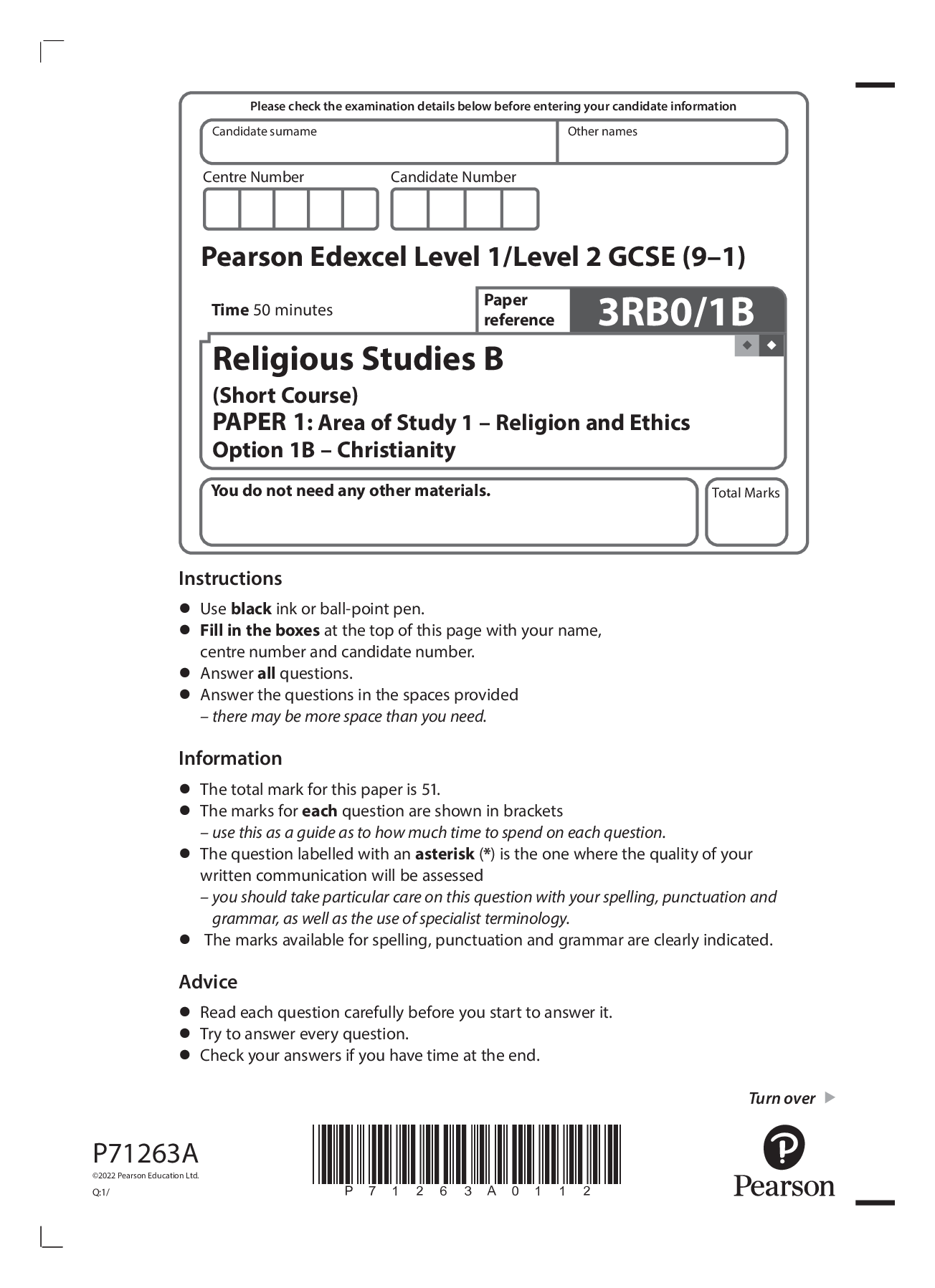

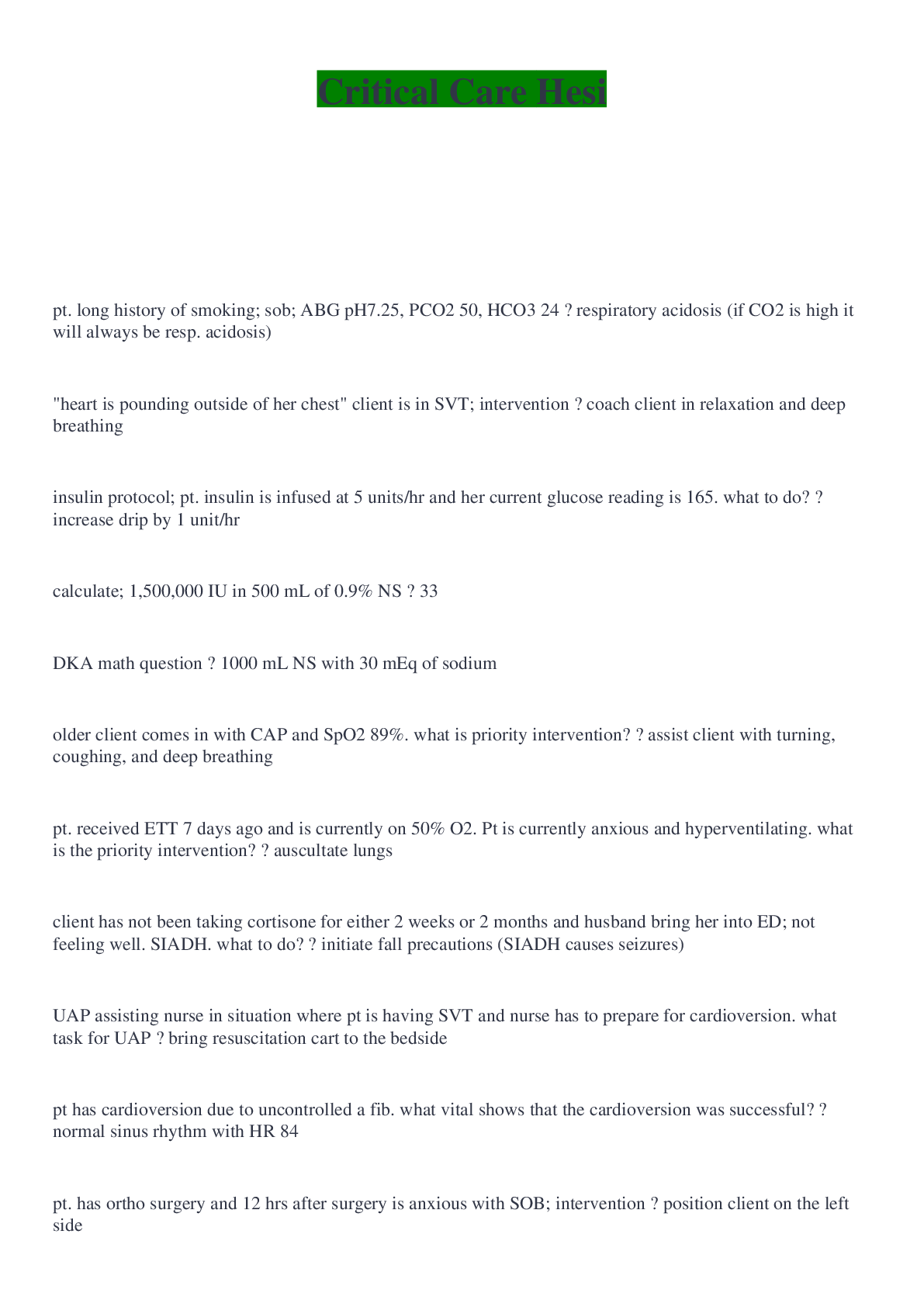
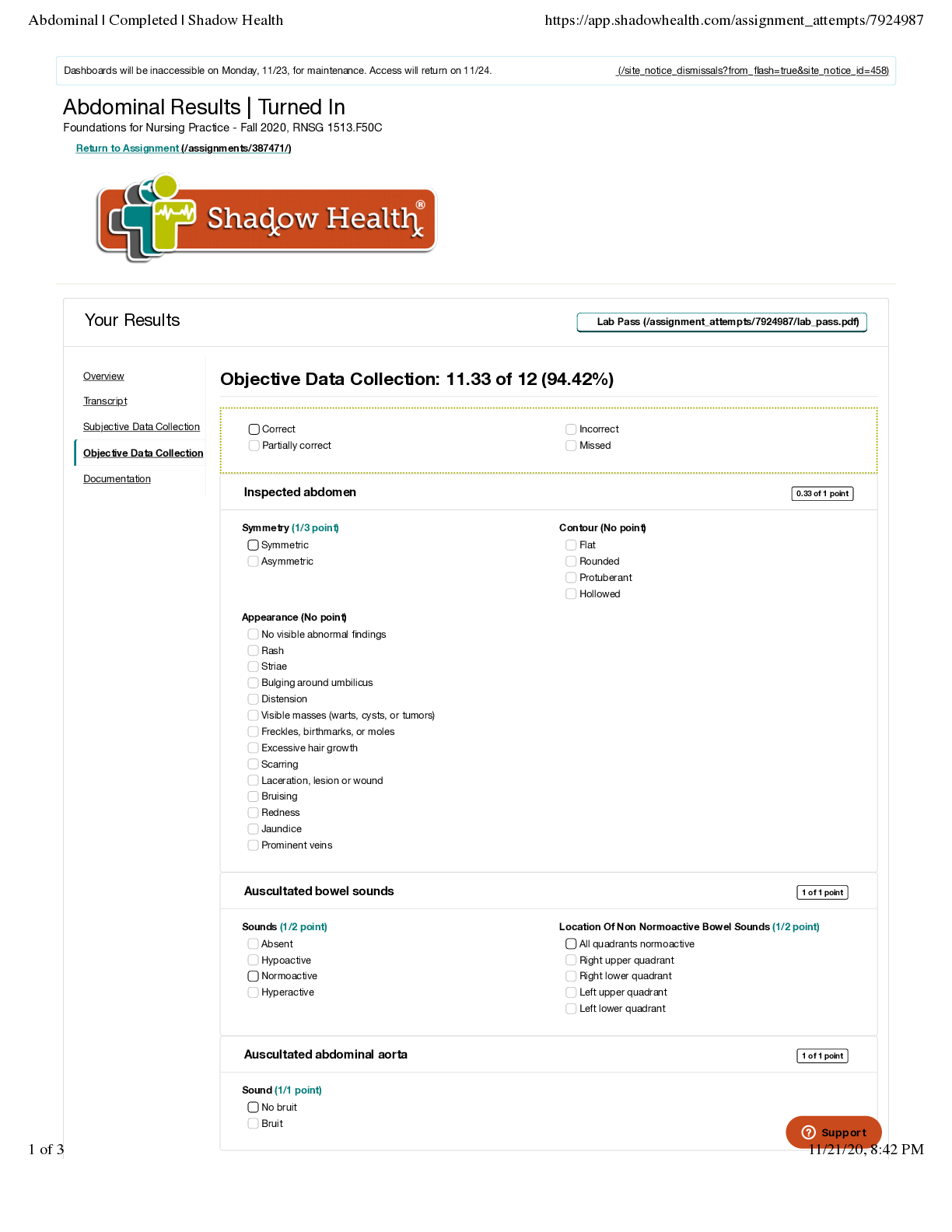
 (1).png)


.png)
